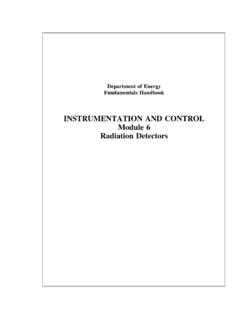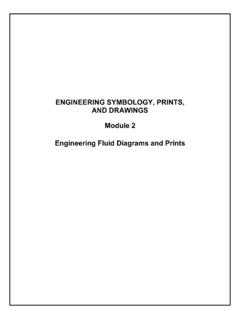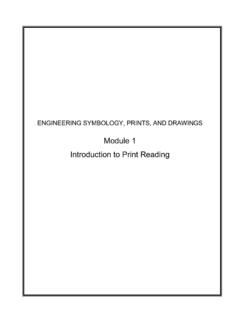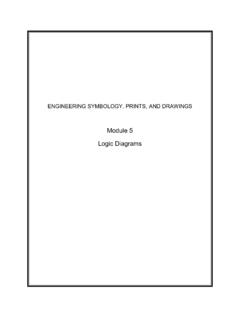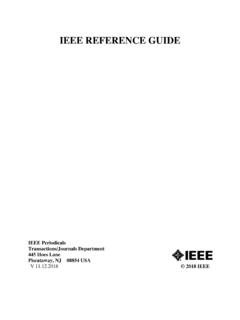Transcription of Module 4 Electronic Diagrams and Schematics - Energy
1 ENGINEERING SYMBOLOGY, PRINTS, AND DRAWINGS Module 4 Electronic Diagrams and Schematics Engineering Symbology, Prints, & Drawings Electronic Diagrams & Schematics i TABLE OF CONTENTS T able of Co nte nts TABLE OF CONTENTS .. i LIST OF FIGURES ..ii LIST OF TABLES .. iii REFERENCES ..iv OBJECTIVES .. 1 Electronic Diagrams , PRINTS, AND Schematics .. 2 Introduction .. 2 Electronic Schematic Drawing Symbology .. 3 Examples of Electronic Schematic Diagrams .. 6 Reading Electronic Prints, Diagrams and Schematics .. 8 Block Drawing Symbology .. 13 Examples of Block Diagrams .. 13 EXAMPLES .. 19 Example 1 .. 19 Summary .. 24 Engineering Symbology, Prints, & Drawings Electronic Diagrams & Schematics ii LIST OF FIGURES Figure 1 Electronic Symbols.
2 3 Figure 2 Electronic Symbols (Continued) .. 4 Figure 3 Example of an Electronic Schematic Diagram .. 5 Figure 4 Comparison of an Electronic Schematic Diagram and its Pictorial Layout 6 Figure 5 Transformer Polarity Markings .. 7 Figure 6 Schematic Showing Power Supply Connections .. 8 Figure 7 NPN Transistor-Conducting .. 9 Figure 8 NPN Transistor-Nonconducting .. 9 Figure 9 PNP Transistor .. 10 Figure 10 Diode .. 10 Figure 11 Bistable Symbols .. 11 Figure 12 Example Blocks .. 12 Figure 13 Example Block Diagram .. 13 Figure 14 Example of a Combined Drawing, P&ID, Electrical Single Line, and Electronic Block Diagram .. 15 Figure 15 Example Combination Diagram of Electrical Single Line, and Block 16 Figure 16 Example 1 .. 19 Figure 17 Example 2.
3 22 Engineering Symbology, Prints, & Drawings Electronic Diagrams & Schematics iii LIST OF TABLES NONE Engineering Symbology, Prints, & Drawings Electronic Diagrams & Schematics iv REFERENCES ASME , Dimensioning and Tolerancing. IEEE Std 315-1975 (Reaffirmed 1993), Graphic Symbols for Electrical and Electronic Diagrams . Gasperini, Richard E., Digital Troubleshooting, Movonics Company; Los Altos, California, 1976. Jensen - Helsel, Engineering Drawing and Design, 7th Ed., McGraw-Hill Book Company, New York (August 15, 2007). Lenk, John D., handbook of Logic Circuits, Reston Publishing Company, Reston, Virginia, 1972. Wickes, William E., Logic Design with Integrated Circuits, John Wiley & Sons, Inc, 1968. Naval Auxiliary Machinery United States Naval Institute, Annapolis, Maryland, 1951.
4 TPC Training Systems, Reading Schematics and Symbols, Technical Publishing Company, Barrington, Illinois, 1974. Arnell, Alvin, Standard Graphical Symbols, McGraw-Hill Book Company, 1963. George Masche, Systems Summary of a Westinghouse Pressurized Water Reactor, Westinghouse Electric Corporation, 1971. Smith-Zappe, Valve Selection handbook , 5th Ed., Gulf Publishing Company, Houston, Texas, December 2003. Engineering Symbology, Prints, & Drawings Electronic Diagrams & Schematics 1 . OBJECTIVES TERMINAL OBJECTIVE Given a block diagram, print, or schematic, IDENTIFY the basic component symbols as presented in this Module . ENABLING OBJECTIVES IDENTIFY the symbols used on engineering Electronic block Diagrams , prints, and Schematics , for the following components.
5 A. Fixed resistor o. Fuse b. Variable resistor p. Plug c. Tapped resistor q. Headset d. Fixed capacitor r. Light bulb e. Variable capacitor s. Silicon controlled rectifier (SCR) f. Fixed inductor t. Half wave rectifier g. Variable inductor u. Full wave rectifier h. Diode v. Oscillator i. Light emitting diode (LED) w. Potentiometer j. Ammeter x. Rheostat k. Voltmeter y. Antenna l. Wattmeter z. Amplifier m. Chassis ground aa. PNP and NPN transistors n. Circuit ground bb. Junction STATE the purpose of a block diagram and an Electronic schematic diagram. Engineering Symbology, Prints, & Drawings Electronic Diagrams & Schematics 2 Electronic Diagrams , PRINTS, AND Schematics To read and understand an Electronic diagram or Electronic schematic, the basic symbols and conventions must be understood.
6 EO IDENTIFY the symbols used on engineering Electronic block Diagrams , prints, and Schematics , for the following components. a. Fixed resistor o. Fuse b. Variable resistor p. Plug c. Tapped resistor q. Headset d. Fixed capacitor r. Light bulb e. Variable capacitor s. Silicon controlled rectifier (SCR) f. Fixed inductor t. Half wave rectifier g. Variable inductor u. Full wave rectifier h. Diode v. Oscillator i. Light emitting diode (LED) w. Potentiometer j. Ammeter x. Rheostat k. Voltmeter y. Antenna l. Wattmeter z. Amplifier m. Chassis ground aa. PNP and NPN transistors n. Circuit ground bb. Junction EO STATE the purpose of a block diagram and an Electronic schematic diagram. Introduction Electronic prints fall into two basic categories, Electronic Schematics and block Diagrams .
7 Electronic Schematics represent the most detailed category of Electronic drawings. They depict every component in a circuit, the component's technical information (such as its ratings), and how each component is wired into the circuit. Block Diagrams are the simplest type of drawing. As the name implies, block Diagrams represent any part, component, or system as a simple geometric shape, with each block capable of representing a single component (such as a relay) or an entire system. The intended use of the drawing dictates the level of detail provided by each block. This chapter will review the basic symbols and conventions used in both types of drawings. Engineering Symbology, Prints, & Drawings Electronic Diagrams & Schematics 3 Electronic Schematic Drawing Symbology Of all the different types of Electronic drawings, Electronic Schematics provide the most detail and information about a circuit.
8 Each Electronic component in a given circuit will be depicted and in most cases its rating or other applicable component information will be provided. This type of drawing provides the level of information needed to troubleshoot Electronic circuits. Electronic Schematics are the most difficult type of drawing to read, because they require a very high level of knowledge as to how each of the Electronic components affects, or is affected by, an electrical current. This chapter reviews only the symbols commonly used in depicting the many components in Electronic systems. Once mastered, this knowledge should enable the reader to obtain a functional understanding of most Electronic prints and Schematics . Figure 1 and Figure 2 illustrate the most common Electronic symbols used on Electronic Schematics .
9 Engineering Symbology, Prints, & Drawings Electronic Diagrams & Schematics 4 Figure 1 Electronic Symbols Engineering Symbology, Prints, & Drawings Electronic Diagrams & Schematics 5 Figure 2 Electronic Symbols (Continued) Engineering Symbology, Prints, & Drawings Electronic Diagrams & Schematics 6 Examples of Electronic Schematic Diagrams Electronic Schematics use symbols for each component found in an electrical circuit, no matter how small. The Schematics do not show placement or scale, merely function and flow. From this, the actual workings of a piece of Electronic equipment can be determined. Figure 3 is an example of an Electronic schematic diagram. Figure 3 Example of an Electronic Schematic Diagram A second type of Electronic schematic diagram, the pictorial layout diagram, is actually not so much an Electronic schematic as a pictorial of how the Electronic circuit actually looks.
10 These drawings show the actual layout of the components on the circuit board. This provides a two-dimensional drawing, usually looking down from the top, detailing the components in their location. Shown in Figure 4 is the schematic for a circuit and the same circuit drawn in pictorial or layout format for comparison. Normally the pictorial layout would be accompanied by a parts list. Engineering Symbology, Prints, & Drawings Electronic Diagrams & Schematics 7 Figure 4 Comparison of an Electronic Schematic Diagram and its Pictorial Layout Diagram Engineering Symbology, Prints, & Drawings Electronic Diagrams & Schematics 8 Reading Electronic Prints, Diagrams and Schematics To properly read prints and Schematics , the reader must identify the condition of the components shown and also follow the events that occur as the circuit functions.
